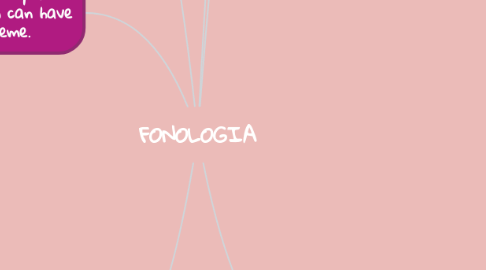
1. The way they are written does not have to look like
2. Fiil/feel, difference between i short /ɪ/ vs /i:/ long
3. PHONEMES Smaller sound units
3.1. Characteristics
3.1.1. Phonological unit makes differentiation.
3.1.2. Each phoneme is delimited according to its characteristics
3.1.3. It is the conductor of a meaningful intention
3.2. Example
3.2.1. /a:/ Like the Spanish MARK
3.2.2. /æ/ Sound of A with mouth position as pronouncing an E: TAX
3.2.3. /f/ How it sounds in spanish: FOLLOW
3.2.4. /l/ Like the Spanish L: ELEVEN and another more enlongated CHALK
3.2.5. /d/ Sound a little more explosive than the D in Spanish: DOOR
4. ALLOPHONES They are variants, which can have the same phoneme.
4.1. Characteristics
4.1.1. They represent genuine pronunciation of a phoneme
4.1.2. Same distinctive features
4.1.3. They have differents non-distinctive, meaning remains
4.1.4. They aren´t contrasting
4.1.5. Definition of words with allophones dn't changue with pitch.
4.2. Example
4.2.1. [b] At the beginning of a word is [be], In the middle of a word is number [ˈnʌmbɚ], Job [ˈdʒɑb]
4.2.2. [k] not aspirated, as in quite [ˈkwaɪt]
4.2.3. [kʰ] aspirated in, with a strong blow of air behind the articulation, as in kill [ˈkʰɪɫ]
4.2.4. [t] not aspirated: Today [təˈdeɪ]
4.2.5. [tʰ] aspirada: Two [ˈTʰu]
5. MINIMAL PAIRS The difference in pronunciation is minimal
5.1. Characteristics
5.1.1. They are words that are very similar
5.1.2. They differ from a single sound
5.1.3. Not only do they appear in single words, they can also appear in sentences short
5.2. Examples
5.2.1. bag/back: Consonant difference /g/ and /k/
5.2.2. Identify phonemes in a language
5.2.3. But/ bought Again the / ʌ / compared to the long vowel in bought
5.2.4. wash / watch – consonants /ʃ/ y /tʃ/
5.2.5. berry / very – the /b/ and the /v/ They are pronounced differently
6. PHONES AND MORPHEMES PRONUNCIATION
6.1. Phonemes
6.1.1. Diphthongs
6.1.1.1. Example
6.1.1.1.1. / ɔɪ / - toy (toy) would sound similar to 'toi'
6.1.1.1.2. / eɪ / - day would sound similar to 'dei'
6.1.1.1.3. / aɪ / - sky (sky) would sound similar to ‘skai’
6.1.1.1.4. / aʊ / - cow (cow) would sound similar to 'cau'
6.1.2. phonemes, Of these, correspond to consonants, to vowels and diphthongs.
6.1.2.1. long vowels
6.1.2.1.1. Example
6.1.2.2. short vowels. long vowels
6.1.2.2.1. Examples
6.1.2.3. consonants
6.1.2.3.1. Example
6.2. Morphemes
6.2.1. Plural: certain morphemes can be pronounced differently depending on their context.
6.2.1.1. Whistling sound / s /, / z /, / ʃ /, / ʒ /, / tʃ /, and / dʒ /. It is necessary to enter an e here because it would be impossible to pronounce an -s after sounds without entering a vowel
6.2.1.1.1. Example
6.2.1.2. No whistling sounds are five: / p /, / t /, / k /, / f /, and / θ /.
6.2.1.2.1. Example
